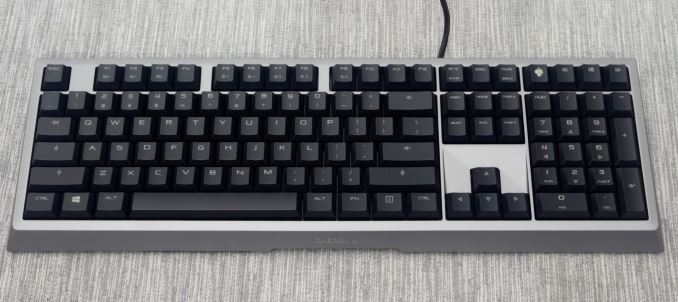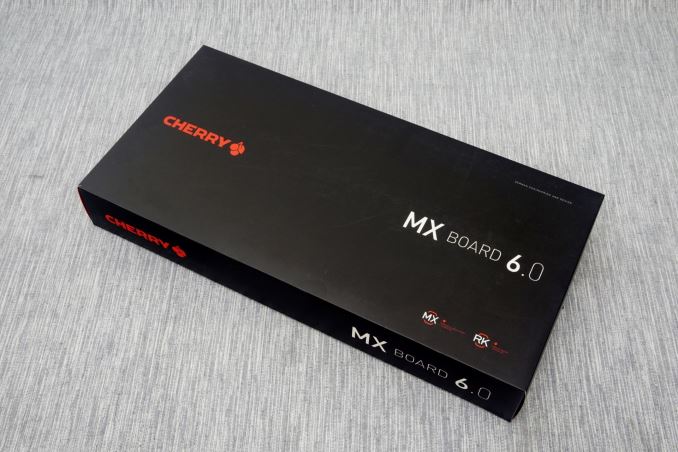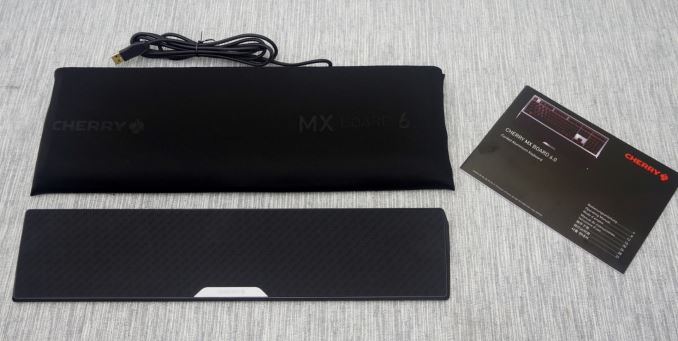The Cherry MX Board 6.0 Mechanical Keyboard Review
by E. Fylladitakis on January 27, 2016 8:00 AM EST- Posted in
- Keyboard
- Cherry MX
- Mechanical Keyboards

We frequently review mechanical keyboards here in AnandTech. Over half of them come with mechanical switches from Cherry, and for good reason. If you are keeping track of our recent reviews, you should have noticed that Cherry's switches generally are more consistent than any other type we have tested to this date. Cherry is virtually the inventor of the modern mechanical keyboard switch (not to be confused with the classic buckling spring), manufacturing and marketing them since nearly three decades ago. It is only because their patent expired that other manufacturers were able to copy their switch designs.
With all of that said, Cherry is not only supplying their switches to other keyboard manufacturers. As a matter of fact, the company has a significant line-up of their own keyboard and mouse products. On the other hand, Cherry's products are almost exclusively aimed towards professionals and for specific applications, such as keyboards with biometric or magnetic card readers for security. Considering the target market of their products, naturally their keyboards were using just plastic black or beige parts and never looked like anything special. However, Cherry is taking a huge leap of faith and releasing a new keyboard, the MX Board 6.0, which a mere glance upon it is enough to reveal that it is nothing like their previous products.
Cherry MX Board 6.0 Keyboard - Key Features and Specifications
- The world's fastest keyboard – with Cherry MX and Cherry RK
- CHERRY MX RED – Gold Crosspoint precision keyswitch for all keys »Made in Germany«
- Aluminium housing with sanded finish and grease resistant coating
- CHERRY RealKey technology – fully analog signal processing
- All keyswitches are read simultaneously
- 100% anti-ghosting - No inputting errors
Packaging & Bundle
The packaging of the MX Board 6.0 is the perfect example of the company's market philosophy; very sturdy, completely plain and painfully serious. It could be run over by a car and there would not be any damage to the keyboard or the rest of the contents, but there is almost nothing eye-catching about it. As a matter of fact, those who do not know of Cherry might not even realize that there is a keyboard inside the box without closely inspecting it.
Inside the box, we found the keyboard inside a very nice and soft pouch-cover, a large wrist rest and a basic manual. The manual is small and simple, but it is clearly written and more than enough for the few extra functions of the MX Board 6.0.
Finally, retail prices for the MX Board 6.0 are hovering around $200, with a price of $198 at the time this article was written.













72 Comments
View All Comments
buxe2quec - Wednesday, January 27, 2016 - link
http://www.cherry.de/cid/Mechanical_keyboards.htm? this is the listSamus - Wednesday, January 27, 2016 - link
Awesome keyboard, but I repeat your "Wow...$200" statement.I mean is it really that much better than a $60 Coolermaster Quickfire with the same MX Red keys?
valentin-835 - Saturday, January 30, 2016 - link
I used to think that way. 200 bucks. What's that ? I know people that spend more than that in a month drinking a lot of Starbucks coffee. Them caffeine junkies !!!voicequal - Wednesday, January 27, 2016 - link
Once you get adjusted to MX Red it's hard to go back to MX Brown. I have two Kinesis keyboards, the first was MX Brown, the 2nd MX Red. Compared to the MX Red, the MX Brown feels sticky and requires harder key presses, but then bottoms out abruptly. MX Red has light but consistent actuation force that allows faster typing while reducing fatigue, once you learn to not hammer the keys. I use the MX Red at work while the MX Brown stays home, while I've come to prefer the MX Red overall.MrSpadge - Wednesday, January 27, 2016 - link
Interesting. I definitely prefer MX Brown over MX Black. And I've got 2 examples for Brown's: a basic Cherry for ~50€ at work and a.. oh dear, forgot the name. From some other company for 120€, a heavy unit with a solid back plate. The keys feel so much better on that one, precise and light compared to "a bit mushy" - it's amazing. I would have sworn they use different ones if I didn't kow better.MrSpadge - Wednesday, January 27, 2016 - link
The better one is a Celeritas.BurntMyBacon - Thursday, January 28, 2016 - link
@MrSpadge: "... a heavy unit with a solid back plate. The keys feel so much better on that one, precise and light compared to "a bit mushy" "This is exactly my experience. I've had the opportunity to use browns and blacks at work. Waiting till prices are better in general for home as I'd like a backlit mechanical keyboard with a solid back plate for my dark environment, but I'm unwilling to pay the current going price for it. If the keyboard has flex in the back plate, the keys feel sticky and require a lot more actuation force. A solid back plate allows you to accurately feel the crossover point and waste no more time or energy on the key press. Blacks aren't really that bad for me, but with no feedback to tell me it has actuated, I end up bottomed out or nearly so every key press. Given that reds are less resistive, I'd probably be bottoming out every time.
guidryp - Wednesday, January 27, 2016 - link
People are different and I suppose you can get used to anything.But Browns and "harder key presses" doesn't make much sense, these are extremely light press keys.
That "bottoms out suddenly" is the tactile breakover effect, and is exactly what I want in a keyboard switch. It's the only reason I want a mechanical keyboard. I despise the linear black and red keys with the Linear keys you get no tactile cue about actuation, except bottoming them out.
voicequal - Thursday, January 28, 2016 - link
The Kinesis also helps by playing an audible "tick" sound when the key actuates. I've kept this on with both the Brown and Red, and I recall I did have trouble detecting feedback when I turned it off.I guess if the key is going to bottom out hard anyway, I'd rather have the Red which gives you more control over how fast you bottom out. Since the brown requires more initial force to actuate, your always going to bottom out hard. For me it agitates RSI.
BurntMyBacon - Thursday, January 28, 2016 - link
@voicequal: "The Kinesis also helps by playing an audible "tick" sound when the key actuates. I've kept this on with both the Brown and Red, and I recall I did have trouble detecting feedback when I turned it off."Good information. I didn't know the Kinesis keyboards had that feature. It's too bad the board has enough flex that you can't get a good response from the browns, but it sounds like the audible feedback is responsive enough to make the reds usable. This keyboard is not really in my price range, but perhaps the audible feedback scheme will show up elsewhere in the future.